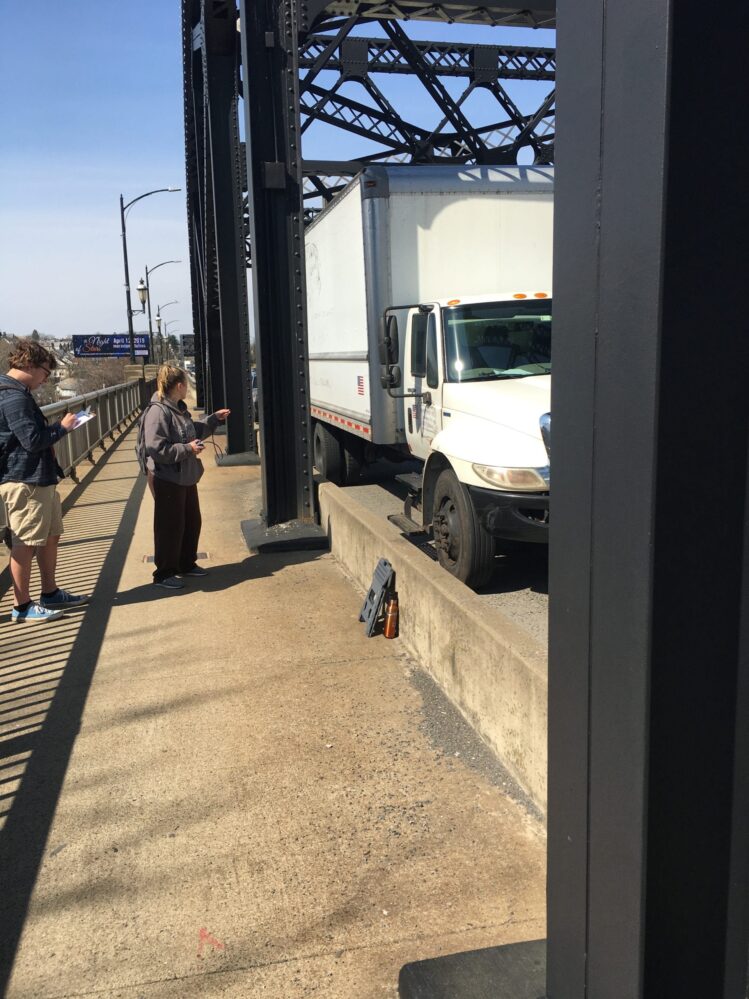The Lehigh Valley is home to many universities and colleges that draw talented students and faculty from around the region, country, and world to further their education and prepare for successful careers. These institutions are centers for a wealth of resources – in terms of knowledge, reputation, people, and funds. They have tremendous capacity to support initiatives that study and aim to directly address important issues, including those that affect the communities where the universities and colleges are located. Often referred to as community engaged scholarship, these types of partnerships between institutions of higher education and the city or region in which they are housed are an increasingly valued way of conducting research.
One such partnership is helping to reduce the impact of air pollution on people’s health in Bethlehem. Dr. Breena Holland, professor of Political Science and the Environmental Initiative at Lehigh University, conducts research monitoring black carbon, which is a component of PM2.5 particles – fine air pollution particles that pose a serious health risk – along various pedestrian routes on Bethlehem’s Southside. This results in recommendations for residents to avoid streets with particular high pollution levels, especially at rush hour, and for government efforts to reduce overall pollution by limiting tractor trailer traffic through certain neighborhoods. I talked with Breena about her work and the benefits and challenges faculty may experience when trying to do research with their local communities.
The air quality monitoring project started almost 10 years ago when the directors of Lehigh’s Southside Initiative, a program that provides institutional resources enabling students, staff, and faculty to “share knowledge, foster democracy, and improve the quality of life in our city,” encouraged Breena to use Initiative funding for projects with the local community to study outdoor air quality. The Southside Initiative had recently brought in a speaker on children’s health and the environment who highlighted the problem of outdoor air quality leading to and worsening asthma, rather than focusing on indoor air quality and asthma as many public health programs and members of the general public were doing at the time. Asthma was a top health concern reported by members of the Southside community in a study conducted by a local health network and the City of Bethlehem, so it was a salient issue to focus on. “It was a combination of hearing from health professionals, who were hearing from the community that this was an issue, having resources at the university concerned with working in the community [through the Southside Initiative], and getting the technology to actually do the study” that made the project possible, Breena says.

PM2.5 particles are 30 times smaller than the diameter of a human hair. Since they are so small, they can get deep into your lungs or even into your bloodstream, making them especially dangerous to human health. Image source: EPA.
With the help of the Southside Initiative’s funding, Breena and her students started going out into Bethlehem with handheld air quality monitors to assess the air quality along routes where children often walked, and where they suspected there might be “hot spots” or big spikes in air pollution during rush hour (i.e. at busy intersections or near parking garages). While the data that informs the air quality reports you may see on the news or in a weather report comes from regional monitors that might be miles away, the handheld monitors allowed Breena and her students to gather data specific to different locations within the city that more accurately represented what pedestrians in the city might actually be exposed to. When she was granted funds from the Pennsylvania Department of Environmental Protection (DEP) in 2012, Breena began working with eighth graders at Broughal Middle School on the Southside as well as Lehigh students. Together they mapped typical walking routes home from school and alternative routes that avoided high traffic areas without adding time to students’ commute. They simultaneously measured black carbon along both routes and found that students’ typical routes along busy roads had significantly more air pollution. The Broughal students presented their findings to their parents. This meeting revealed that while parents weren’t very aware of the risks of air pollution, they were worried about their children traveling on less busy routes as they perceived a potential safety risk due to fewer “eyes on the street.” “The research came up with a solution, but didn’t reveal the barrier of parent safety perceptions,” Breena says. With that additional knowledge from direct relationships with community members, “we could propose the idea of a walking school bus or other ways to travel safely.”
While the project succeeded in teaching the middle schoolers a lot about air quality and how to get to school more safely, Breena acknowledges that it has been challenging to find ways to continue to build that awareness with new middle school students year after year, in large part because projects that involve coordinating and having conversations with the community take a lot of time. Air quality monitoring isn’t Breena’s specific area of research focus, and she is balancing this project with other research and responsibilities of being a professor. For any faculty conducting research, it’s important to set a research agenda for the types of questions they will spend their time studying in the coming years. This has bearing on what entities might fund their work, where they might be able to get their findings published or present about them, and how they fit into their institution’s expectations. All of these factors can affect decisions regarding professional advancement or tenure. For this reason, Breena explains, it’s important for academic institutions to support and encourage their professors engaging in this kind of work. “They can count [community engaged scholarship] toward evaluations for promotions, or provide credit for the work in some other way. It’s especially important when working with under-resourced communities – those people don’t have time to be leading the charge either” she says.

Tractor trailers are a major source of air pollution in much of the Lehigh Valley, including Bethlehem. Photo courtesy of Breena Holland.
Fortunately Breena has been able to continue her air quality monitoring work despite some of those challenges. Recently, Bethlehem was applying for grant money to study the feasibility of building a pedestrian bridge over the Lehigh River, and Breena’s students helped to assess the exposure to pollution along alternate pathways in order to understand how exposure might change if people could utilize a pedestrian bridge. During that study, she and her students observed heavy tractor trailer traffic during rush hour on the Southside, which is now an area for future research. “The DEP needs data showing the problem to get PENNDOT to do something,” she says. “Ideally we could limit truck traffic when kids are walking home from school, or make parent comfort levels higher for their children to walk on non-major roadways.” Air quality monitoring in Bethlehem helps to build public awareness of the issue and provide recommendations to keep people safer and healthier. For Lehigh students, it provides first-hand experience with research and strategies for addressing environmental issues, as well as a way to get engaged with the city they’re part of for at least four years. In this way, community engaged scholarship is one strategy for fostering a mutually beneficial relationship between a college or university and its surrounding community.


